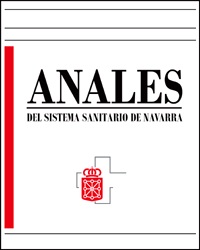Quiste estromal primario de iris: a propósito de un caso
DOI:
https://doi.org/10.23938/ASSN.1072Palabras clave:
Enfermedades del Iris, Quiste, Segmento Anterior del Ojo, Tomografía de Coherencia Óptica, TratamientoResumen
Los quistes estromales primarios de iris son poco comunes, a menudo asintomáticos y de detección incidental; su tratamiento está indicado en casos que presentan crecimiento o complicaciones. Sin embargo, requieren pruebas de imagen para determinar su naturaleza quística y hacer un diagnóstico diferencial preciso con tumores malignos, así como para realizar el seguimiento a lo largo del tiempo. La biomicroscopía ultrasónica es la técnica de elección, pero la tomografía de coherencia óptica de segmento anterior (OCT-SA) es una prueba más accesible y disponible en la mayoría de los centros.
Se presenta un caso de quiste estromal primario de iris de presentación atípica para ilustrar el diagnóstico y seguimiento inicial mediante OCT-SA y fotografías, así como el manejo de las complicaciones. La OCT-SA podría tener su utilidad en el estudio inicial y seguimiento de lesiones anteriores, no pigmentadas y en las que se visualice el quiste en su totalidad.
Descargas
Citas
MARIGO FA, FINGER PT. Anterior segment tumors: current concepts and innovations. Surv Ophthalmol 2003; 48: 569-593. https://doi.org/10.1016/j.survophthal.2003.08.001
REMINGTON LA. Clinical anatomy of the visual system. En: Remington LA, editor. Clinical anatomy of the visual system. St. Louis (Missouri): Elsevier Health Sciences, 2005; 123-143.
SHIELDS JA, KLINE MW, AUGSBURGER JJ. Primary iris cysts: A review of the literature and report of 62 cases. Br J Ophthalmol 1984; 68: 152-166. https://doi.org/10.1136/bjo.68.3.152
PAVLIN CJ, VÁSQUEZ LM, LEE R, SIMPSON ER, AHMED IK. Anterior segment optical coherence tomography and ultrasound biomicroscopy in the imaging of anterior segment tumors. Am J Ophthalmol 2009; 147: 214-219. https://doi.org/10.1016/j.ajo.2008.08.023
RIVERO, V. Uso de la tomografía de coherencia óptica y la biomicroscopía ultrasónica en el diagnóstico de los quistes iridociliares. Arch Soc Esp Oftalmol 2016; 91(6): 300. https://doi.org/10.1016/j.oftal.2016.02.002
HAU SC, PAPASTEFANOU V, SHAH S, SAGOO MS, RESTORI M, COHEN V. Evaluation of iris and iridociliary body lesions with anterior segment optical coherence tomography versus ultrasound B-scan. Br J Ophthalmol 2015; 99: 81-86. https://doi.org/10.1136/bjophthalmol-2014-305218
KREMA H, SANTIAGO RA, GONZÁLEZ JE, PAVLIN CJ. Spectral-domain optical coherence tomography versus ultrasound biomicroscopy for imaging of nonpigmented iris tumors. Am J Ophthalmol 2013; 156(4): 806-812. https://doi.org/10.1016/j.ajo.2013.05.025
GEORGALAS I, PETROU P, PAPACONSTANTINOU D, BROUZAS D, KOUTSANDREA C, KANAKIS M. Iris cysts: A comprehensive review on diagnosis and treatment. Surv Ophthalmol 2018; 63(3): 347-364. https://doi.org/10.1016/j.survophthal.2017.08.009
MINAVI, AZ., HOLDEMAN, NR. Peripheral pigmentary iris cyst: evaluation and differential diagnosis. Clin Exp Optom 2007; 90(1), 49-52. https://doi.org/10.1111/j.1444-0938.2006.00087.x
PEDEMONTE-SARRIAS E, PASCUAL BATLLE L, FUSTE FUSARES C, SALVADOR PLAYA T. [Fine-needle aspiration in an extremely late post-traumatic iris cyst]. Arch Soc Esp Oftalmol 2015; 90(7): 324-326. https://doi.org/10.1016/j.oftal.2015.02.020
ROTSOS T, DIAGOURTAS A, SYMEONIDIS C, PAPACONSTANTINOU D, GEORGOPOULOS G. Phacoemulsification in a patient with small pupil and a large iris cyst. Eur J Ophthalmol 2012; 22(2): 278-279. https://doi.org/10.5301/ejo.5000026
BEHROUZI Z, KHODADOUST A. Epithelial iris cyst treatment with intracystic ethanol irrigation. Ophthalmology 2003; 110(8): 1601-1605. https://doi.org/10.1016/s0161-6420(03)00543-8
SHIELDS CL, AREPALLI S, LALLY EB, LALLY SE, SHIELDS JA. Iris stromal cyst management with absolute alcohol-induced sclerosis in 16 patients. JAMA Ophthalmol 2014; 132(6): 703-708. https://doi.org/10.1001/jamaophthalmol.2014.160
KAWAGUCHI K, YAMAMOTO S, NAGAE Y, OKADA A, IWASAKI N, TANO Y. Treatment of recurrent giant iris cyst with intracyst administration of mitomycin C. Br J Ophthalmol 2000; 84(7): 799. https://doi.org/10.1136/bjo.84.7.799b
LAI MM, HALLER JA. Resolution of epithelial ingrowth in a patient treated with 5-fluorouracil. Am J Ophthalmol 2002; 133(4): 562-564. https://doi.org/10.1016/s0002-9394(01)01419-2
SUGAR J, JAMPOL LM, GOLDBERG MF. Argon laser destruction of anterior chamber implantation cysts. Ophthalmology 1984; 91(9): 1040-1044. https://doi.org/10.1016/s0161-6420(84)34184-7
SCHREMS W, TOMLINSON CP, BELCHER CD III. Neodymium-YAG laser therapy for iris cysts. Arch Ophthalmol 1986; 104(8): 1130-1134. https://doi.org/10.1001/archopht.1986.01050200036033
Publicado
Cómo citar
Número
Sección
Licencia

Esta obra está bajo una licencia internacional Creative Commons Atribución-CompartirIgual 4.0.
La revista Anales del Sistema Sanitario de Navarra es publicada por el Departamento de Salud del Gobierno de Navarra (España), quien conserva los derechos patrimoniales (copyright ) sobre el artículo publicado y favorece y permite la difusión del mismo bajo licencia Creative Commons Reconocimiento-CompartirIgual 4.0 Internacional (CC BY-SA 4.0). Esta licencia permite copiar, usar, difundir, transmitir y exponer públicamente el artículo, siempre que siempre que se cite la autoría y la publicación inicial en Anales del Sistema Sanitario de Navarra, y se distinga la existencia de esta licencia de uso.








